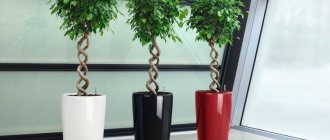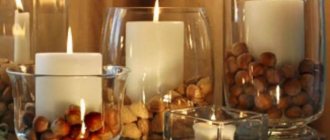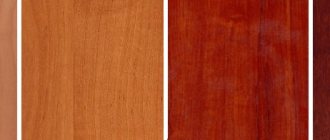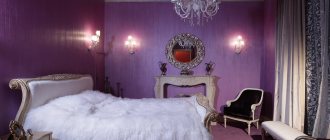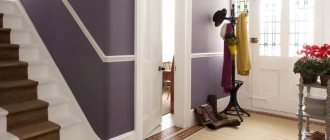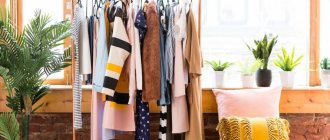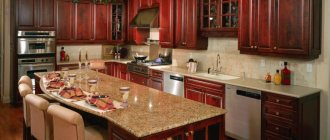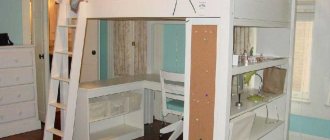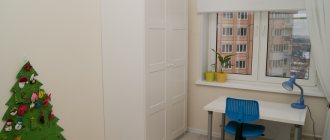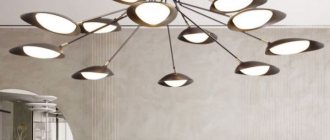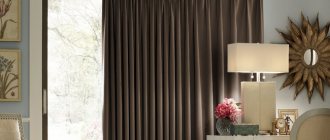In the interior
This is an elegant touch in the design of the room, which emphasizes the style and gives a special unique charm. Vases with a height of more than 40 cm are considered floor-standing. It is not recommended to place items of shorter height on the floor so that they do not get lost against the background of a large space. Such decorations are usually installed on the floor, thresholds, in niches or on low stands.
This accessory came into the modern art of decorating a room from Ancient Greece, where skilled craftsmen created real masterpieces. Initially, large-volume vases were intended for storing various liquids, amphora, and bulk substances. Later they began to be used simply as decorative items. Most often, such decorations were found in the homes of the rich and aristocrats, and therefore were considered a luxury item. In this sense, little has changed today. Large decorative vessels are also a symbol of prosperity and sophistication.
Floor vases come in various shapes. These are elongated narrow vessels, antique jugs, bottles. There are also triangular, square, flattened, conical varieties. By playing with the silhouette, color and texture of the flowerpot, you can achieve a completely unexpected effect. Various techniques will help create the integrity of the room or, conversely, divide the space into zones.
Types and varieties
Vases of various shapes, sizes, and types are used. This detail can emphasize the stylistic direction, hide the shortcomings of the room, or can become its center, reflecting the design idea.
Vases are:
- floor;
- floral;
- decorative.
Floor vases are designed for rooms with a large area and high ceilings. Due to the fact that floor vases are large, in a tight space they will look “squeezed” and awkward.
Vases with a height of 40 cm or more look advantageous on the floor
Large floor vases love spacious spaces
Flower vases do not act as a separate piece of furniture, but these objects can effectively emphasize the unusualness and beauty of a decorative or festive bouquet.
Decorative vases are rarely suitable for flowers; more often they are the final touch, emphasizing the style and design.
Before buying a vase, you need to decide where it should stand and what it will be combined with.
Vases with paintings, especially handmade ones, are most valued
These vessels are also divided by shape - there are vases-jugs, round in shape and with a narrow neck; There are drop-shaped, cylindrical, and modern square ones.
See alsoChair covers for the kitchen, photo.
Design tips
- Before purchasing a large decorative vessel, you need to think very carefully about where it will stand and what it will look like. The range of shades, shape, and material of the product play an important role;
- The color should not stand out from the general palette. The flowerpot should either be in harmony with the rest of the items, or serve as a bright accent along with other decor;
- A floor vase should not be too light. This is especially true when there are children or active pets. In this case, it is better to give preference to interesting vessels made of wood, metal or other unbreakable materials. If, nevertheless, your gaze falls on a fragile object, you can pour a little sand or small stones onto the bottom to make it heavier;
- It is better to place expensive or rare specimens on special stands that will help avoid damage;
- Large vases should be placed along the wall and not in the middle of the room. The best place is a spacious corner. In this case, there will be no feeling of excessive cluttering of objects.
Decorating the room
If space allows, you can install not one, but several vessels at once. There are many options for such a composition. These can be two identical vases placed on different sides of the room or some piece of furniture. Several flowerpots of the same shape and texture, but of different sizes, installed next to each other look interesting. Such an ensemble can become the central element of the room, attracting attention.
Floor vases love space. Therefore, there is no need to place them close to the furniture. Let there be some space around. Alternatively, you can place the vase near a free window.
Unusual solutions
Collecting interesting items? Store your collection in a vase on a shelf or table.
Rusty items
A play of contrasts can add some charm to the interior. You can achieve this effect by simply adding a decorative element. It could be an airy glass vase with something rough, black or rusty inside.
Old scissors, bolts and nails: everything you can find in the garage can be used in decor:
Traffic jams
Some people collect wine corks. Do not put them in a box or drawer. Create a composition in a glass vase.
This decor will fit into an interior in a loft style or similar ones. It is advisable to dilute wine corks with some additional element.
Glass balls
Glass beads create a feeling of fragility and airiness. You can find them at a craft store.
Candles
To make a composition in a minimalist style, place a single-color candle in a transparent glass vase:
Another option: first add pebbles, sand or grains to the bottom of the vase:
What to put in an interior vase
Floor vases are a completely independent item. Often they don't need anything to be installed at all. But if you wish, you can choose artificial flowers on long stems, ears of corn, dried flowers, and bamboo compositions. The design can be changed depending on your mood or time of year. For example, for New Year's Eve you can prepare a bouquet of spruce or pine paws, and for Easter stock up on fluffy willow branches. In summer you can put freshly cut fresh flowers with long stems. The most daring home owners can bring extraordinary design ideas to life. For example, you can put a wire abstract sculpture inside.
The main rule is to maintain proportions when filling. A lush bouquet will look interesting in wide vases. And for narrow, tall vessels, only single flowers or tall compositions of several elements are permissible.
It's very interesting to experiment with transparent vases. They can be filled with colored pebbles, decorative sand, and glass beads. And in wide pots, craftsmen create original compositions from shells, dried fruits and berries, small figurines and other scrap materials.
Products with a large neck can become the basis for creating a mini-garden. To do this, you need to carefully consider the composition, select plants that will grow comfortably in the conditions of a particular room.
Filling options
Flowers (live, artificial)
Flowers are the first thing that comes to mind when asked what to put in a vase. Fresh flowers undoubtedly look more elegant and fill the room with a delightful aroma.
The photo shows a glass floor vase-pot with matte coating, decorated with beads and lace.
However, not every product is adapted to live plants, or rather to water. Ceramic, glass, crystal and porcelain vessels are suitable for this. For other floor vases, it is better to choose artificial flowers. They do not lose their appearance and do not require complex care, which allows you to enjoy the appearance of plants for a long time.
For example, for a classic living room you can choose lush tea roses, orchid or sakura branches for an Asian style, and fragile irises for a modern interior.
The photo shows a tall teardrop-shaped vase with voluminous filling in the form of knitted flowers.
Branches
Painted branches are suitable for modern and minimalist designs. The appearance is not provocative and complements the overall picture.
Dried flowers
Natural dried flowers differ from artificial decoration; each plant looks individual. However, dried flowers are very fragile, it is worth taking this into account when arranging.
Greenery
It can be natural or artificial, in any case it will add a touch of freshness to the interior of the room. Depending on the shape of the flowerpot, the leaves can be straight like grass or fluffy and voluminous.
Feathers
The extravagant filling will attract attention and decorate the stylish interior. Feathers will look good in a plain, simple-shaped vase.
In interior styles
- Chrome accessories are relevant for a high-tech home.
- In a classic room you can place a luxurious hand-painted ceramic vessel. A simple vase in white or black would also be appropriate. Fresh flowers will add a touch of sophistication.
- Clear contour lines and geometric patterns perfectly highlight the Egyptian style.
- Wooden vases, imitation branches, ethnic patterns are an integral attribute of an “African” room.
- Designers advise fans of minimalism to opt for transparent, narrow accessories. You can also put a large vessel, which will be the central element and have interesting shapes or textures.
- Lovers of shabby chic romance will be happy to contemplate compositions of pastel shades with the effect of worn paint.
- A bright accessory of an unusual shape will complement the avant-garde interior. The absence of clear rules, an unusual combination of elements, and boldness are the main features of this design.
Color selection
The color of the vase should match the picture of the house and complement it elegantly.
| Color | Description | Photo |
| White | The white floor vase looks impressive as a separate decorative element, as well as with any filling. | |
| Black | A dark floor flowerpot can be combined with pieces of furniture and decor. | |
| Black and white | The classic black and white combination will complement the modern design. Colors can be combined in one product or in the form of a composition of two different vases. | |
| Gold | Gold will add warmth and luxury. Suitable for decorating modern, oriental, high-tech style. | |
| Red | A bright color can complement other decorative elements, such as a painting or sofa cushions. | |
| Brown | Combines with light finishes in a warm palette, such as beige walls. | |
| Blue | The rich blue color can be present in just a few details, like decoration, this will be enough. | |
| Green | A green floor flowerpot will decorate a modern and eco style. | |
| Grey | The color unobtrusively and elegantly complements the design of the room. Combines well with other shades. | |
| Yellow | A summer yellow shade can be used as a bright accent in the interior of a living room or hallway. | |
| Violet | The rich purple tone of the vase is combined with fresh flowers and textile details in the interior | |
| Blue | The delicate blue shade is suitable for interior decoration in both modern and classic styles. | |
| Turquoise | The turquoise floor decor combines well with clear glass flowerpots and gold details. |
Materials
The materials for such home decorations are amazingly diverse. It could be:
- Ceramics. The prototype of a modern ceramic vase is the same ancient Greek clay vessels. They have an aesthetically pleasing, cozy appearance, allowing you to harmoniously fill almost any corner of the house;
- Tree. Wooden vases with a simple appearance are suitable for lovers of minimalism. And fans of ethnic styles can look for products with a looser silhouette made of wood, bamboo or wicker. Vessels where the glass base seems to be entwined with wooden branches look very interesting and unusual;
- Glass. Glass floor vases look very elegant. They are suitable even for small rooms where there is at least a little free space. The technology for producing glass vessels is quite simple. Therefore, they can have intricate outlines, a wide range of colors, and unusual decorative elements. Glass vases are inexpensive. In combination with the variety of types, they are very popular among designers and inhabitants of modern homes;
- Metal. Strict outlines, clear lines, and a shiny surface will fit perfectly into the concept of a modern home. And if you decorate a metal vase with intricate patterns, they will fit perfectly into a room with a vintage design;
- Porcelain and faience. These are perhaps the most common materials that have been used since ancient times and have not lost their relevance today. The process of making such vessels is very labor-intensive. Before receiving an elegant piece of decor, the craftsman must give it the desired shape, fire it, apply a layer of glaze, and decorate it with painting or stucco. Therefore, porcelain vases are one of the most expensive of the entire range.
In addition to the usual materials, designers use solutions that are unusual at first glance. More and more often you can find vases made of coconut shells, tree bark, and steel tubes. You shouldn't pass by such options. Perhaps just such an accessory will be the ideal solution for a particular home.
Design
carved
The vessels are made of ceramics, wood or plastic. Even large items look elegant and resemble lace. The items are quite light and should be placed in a safe place.
With painting
The style of painting can be either modern or with an ethnic slant, for example, a Gzhel pattern in a soft blue color. The pattern can be repeated in other interior items or support the overall theme of the design.
Vase-lamp in the form of a flower
The product not only performs a decorative function, but also acts as additional lighting. The model is suitable for the interior of a bedroom, nursery or living room. Will harmoniously complement the interior in classic and modern style. Such a product does not require additional decor; the vase already represents a completed image.
Vase-floor lamp
A floor lamp vase will make the interior of your bedroom or living room cozier and warmer. Depending on the style of the room, lamps can have a warm or cool glow.
Vase-pots
A floor vase-planter looks like a large flower pot, and a clay product will look especially impressive. The model is suitable for many styles, such as oriental, modern, classic, ethnic and others.
The photo shows an eco-style interior with a massive floor vase made of plaster, imitating stone.
Openwork
Incredibly delicate and beautiful products resemble weightless lace. The vase is light and fragile, made by hand. The material of the product is most often ceramic.
With rhinestones
Rhinestones will add sparkle and chic to your floor decor. Such a product will decorate the interior in a modern style. A small number of rhinestones successfully complement a vase with a floral pattern.
DIY design
Even the simplest floor vase will become a unique decorative item after it is decorated with your own hands, for example, using the decoupage technique.
In different rooms
Bedroom
It is advisable to choose calm shades in the relaxation room that promote relaxation. More often they are placed opposite the place to sleep. This way, balance is achieved between the parts of the room. Living room. In a place where the whole family gathers to chat and spend a joint evening, you can approach the choice of accessory much more boldly. Experimenting with different colors and unusual silhouettes will allow you to create accents in the space without disturbing its overall harmony.
Hallway
Choosing decorations for the hallway is not an easy task. The decorations in the hallway set the tone for the entire room. Before purchasing a large flowerpot, you need to carefully consider what the owners of the house want to show to guests. Bright colors and asymmetrical vessels will tell about the eccentricity and originality of all residents. Strict forms and calm colors, on the contrary, emphasize restraint and conciseness.
Kitchen and dining room
A large planter in the kitchen will add elegance and elegance. This is the case when it is appropriate to think about the composition for filling. The ideal option would be a bright composition with artificial or live plants. Such an accessory will put residents and guests in a positive mood and will always lift their spirits. If the entire dining room is designed in a simple style, a simple vessel will be enough to add elegance and charm to the room.
Children's
Floor vases in a children's room are not as common as in other parts of the house. But it is in vain that parents neglect this decorative element when creating the interior. A dim vessel of a classic shape can be complemented with plants of delicate tones. The main point when choosing jewelry is environmental friendliness and safety.
Green witchcraft
Vases - flowerpots with various types of flowers and other indoor plants can transform the interior of one of your rooms into a garden or greenhouse, where you can indulge in relaxation and relaxation, or have a picnic with friends without leaving home. More ideas for creating a home greenhouse.
Imbued with the aura of green plants, you will feel how communication with living nature has a wonderful effect on your immediate well-being and overall health. Plants saturate us with vigor and tranquility, which we need, like oxygen in the air, in the modern world of stress and disasters. In addition, it will be just a storehouse of pleasant aromas - if everything is chosen and decorated correctly. And if you are very lucky, and in a magical set of Chinese vases, a florist, who came on the exclusive recommendation of your most mysterious acquaintances, plants a fern seed, placing your vases according to all the rules of Feng Shui, then one day you will be able to see a fern bloom right in your living room . Believe me, it's very beautiful.
A real miracle
The importance of vases in interior design is very great. After all, they make you feel constantly surrounded by beauty and a festive mood, even among gray everyday life.
They look so cozy and charming in any interior of the room that, once you have used vases in your design, it is difficult to give it up.
Floor vases can create a real miracle, filling, for example, a seemingly superfluous empty section of a room, for which the size of the most fashionable set of furniture that was just brought into the apartment was not enough, or the emptiness in the house that appeared when your great-grandmother’s old wardrobe collapsed under the weight centuries.
They will make your rooms feel lived-in and cozy without overloading the decor with unnecessary furniture elements. And the room whose interior you are decorating will immediately become a cozy home or a pleasant office room, or maybe even the hall of a museum or library with a world-famous name.
From ancient times and distant countries, a tradition has come to us - to keep vases in our homes for various purposes and see their beauty, filling our homes with them.
And indeed - not only in the old days, but even in our time, they will always be appropriate next to a person. Their beauty transforms our homes, ennobling the interior, entertaining our eyes, adding variety to the design and making it more elegant. Vases in interior design symbolize the humanity of its inhabitants, the well-being of their environment, show the kindness of the owners and their spiritual beauty.
Georgy Krysyuk
With your own hands
If there is no vase on sale that the owner of the room sees in his interior, do not be upset and give up this idea. There are many ways to decorate a vase yourself. A rich assortment of creative materials will allow you to bring to life the most daring and unusual ideas.
To do this, just purchase a vessel of the desired size and shape and decorate it to your taste. Here are a few ideas that will help you create a unique masterpiece that will only exist in one copy:
- Cover a ceramic vase with round cuts of branches, shells or unnecessary coins;
- Paint the inside of transparent vases in different colors. You can make either a plain vessel or come up with an intricate pattern;
- Braid a simple glass vase with branches or wrap it with twine;
- Decoupage technique is very popular. Special napkins with various elements allow you to create any design from romantic delicate flowers to unusual ethnic motifs;
- A glass floor vase, on top of which is placed a “cover” of coarse knitting made of wool yarn, will look homely; a design for such a design can be found on the Internet;
In addition, instead of a ready-made vase, you can use the most unexpected objects. For example, an old can painted with shiny paint can become a wonderful decoration for a country house. A large-volume bottle is generally a universal item that is suitable for any place, depending on the decor.
A floor vase is a universal tool that can create a unique atmosphere in the home. The main thing is to think through all the parameters before purchasing jewelry so that the result looks holistic and harmonious.
Hand-made
Decorating the interior with items made from scrap materials is a pleasant and inexpensive activity. Use newspapers, coffee beans, accessories, beads, ribbons and other things that every needlewoman has.
Papier-mâché compositions
Papier-mâché is a moldable mass that consists of shredded paper and cardboard. It's not difficult to make. For papier-mâché you will need paper (newspaper is most often used), some water and PVA glue.
- You need to tear the paper, soak it in enough water and beat the mass with a mixer.
- Squeeze out excess moisture (a little), combine with PVA glue and mix.
- Form balls of the required size from the resulting sticky mass. Leave until dry. If you plan to string them onto stems, it is better to do this when the balls are only half dry.
- Finished elements can be painted in any color using a brush or sponge. If you plan to add decoration, the balls are coated with water-based paint, sanded and then decorated.
You can decorate the blanks with beads, make flowers, Christmas tree decorations, Easter eggs, etc. from balls.
For example, cover them with aromatic coffee beans:
Spikelets of coffee beans
Making spikelets is even easier than making balls. You won't need papier-mâché anymore. The stem is covered with a piece of cardboard, onto which the grains are fixed, and the spaces between them are filled with ground coffee.
Spirals made of vine
The vine is flexible and pliable. When processed in a certain way, it twists into a bizarre spiral, which can be used to complement a composition of branches or dried flowers.
Vine processing:
- Pick up thin branches.
- Remove the bark from them.
- Soak for several hours to make it flexible.
- Carefully twist each vine into a spiral onto a stronger branch. You should start from the thinnest tip.
- Secure the vine to a branch and leave to dry for a day.
- After drying, remove the resulting spiral from the base branch.
Finally, spray with hairspray to help the spirals retain their shape longer.
Products made of beads and wire
Needlewomen who know how to work with beads can weave a flower or even a bouquet:
A simpler option is minimalistic branches:
